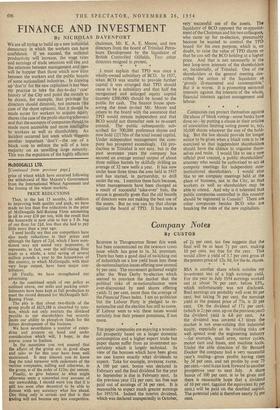Company Notes
' By CUSTOS BUSINESS in Throgmorton Street this week has been concentrated on the DORMAN LONG issue which has gone to Is. 3d. premium. There has been a good deal of switching out of industrials on a low yield basis into these de-nationalisation issues offering now around 61 per cent. The movement gathered weight after the West Derby by-election which seemed to convince the market that the political risks of re-nationalisation were over-discounted by steel shares offering yields 21 per cent. more than the,average of the Financial Times index. I am no politician but the Labour Party is pledged to re- nationalise and the election has still to come. If Labour were to win these issues would certainly lose their present premiums, if not more.
• • • THE paper companies are enjoying a wonder- ful prosperity based on a larger domestic consumption and a higher export trade but paper shares suffer from an investment un- certainty which is largely technical. In view of the bonuses which have been given no one knows exactly what dividends to expect. Take for example, INVERESK PAPER. A 100 per cent. bonus was declared in February and the final dividend for the year to September is due in February next. In the previous year 12} per cent. tax free was paid out of earnings of 34 per cent. It is reasonable to expect much greater earnings for 1953/54. Indeed the interim dividend, which was declared unexpectedly in October, of 21 per cent. tax free suggests that the final will be at least 7} per cent. making 10 per cent. tax free for the year. This would allow a yield of 5.7 per cent gross at the present price of 12s. 9d. for the 4s. shares. • • • BSA is another share which satisfies my investment test of a high earnings yield. For the year to July 1954 earnings worked out at about 76 per cent. before EPL, which unfortunately was not disclosed. Real earnings are probably well over 80 per cent. but taking 76 per cent. the earnings yield at the present price of 73s. is 20 per cent. On the dividend of 171 per cent. (which is 2/ per cent. up on the previous year) the dividend yield is 4/8 per cent. As the dividend was covered 4.3 times the market is not over-valuing this industrial equity, especially as its trading risks are well spread over the engineering industry —for example, small arms, motor cycles, motor cars and buses, and machine tools. Under the able direction of Sir Bernard Docker the company had a very successful year's trading—gross profits having risen by 34 per cent. and net profits by over 75 per cent.—and it can look forward to another prosperous year to next July. A share bonus of 100 per cent. is to be given and there is reasonable hope that a dividend of 10 per cent. (against the equivalent 81 Per cent.) will be paid on the doubled capital. The potential yield is therefore nearly 51 per cent.










































 Previous page
Previous page